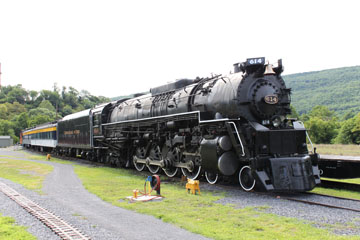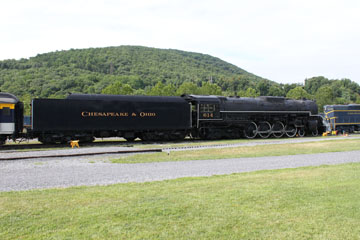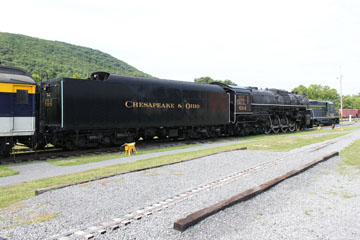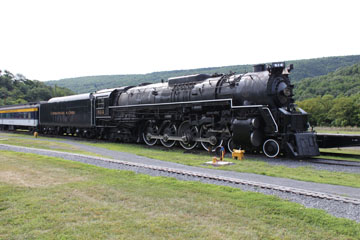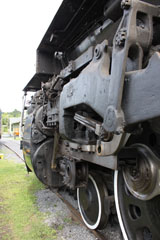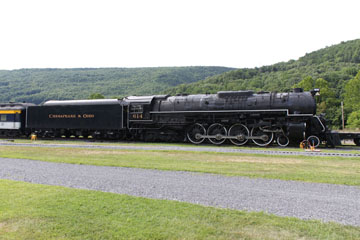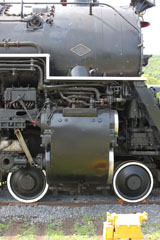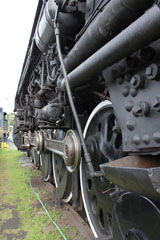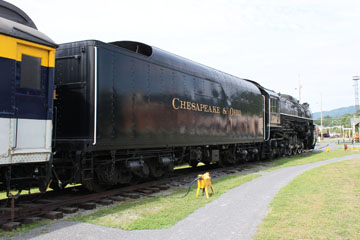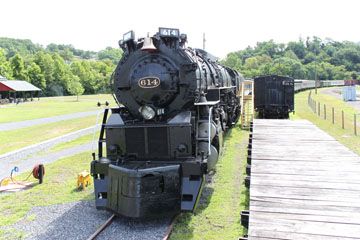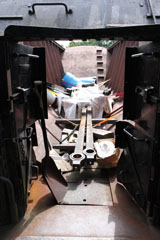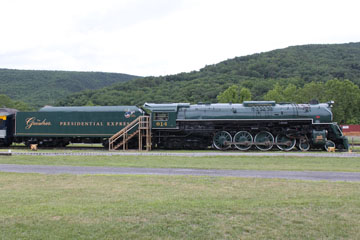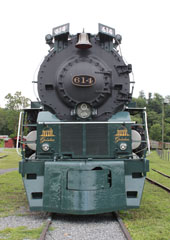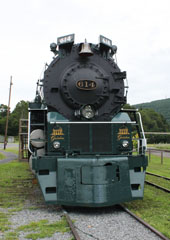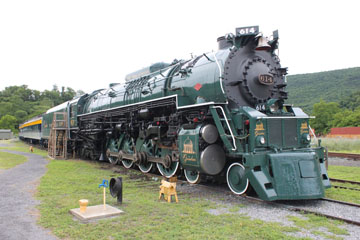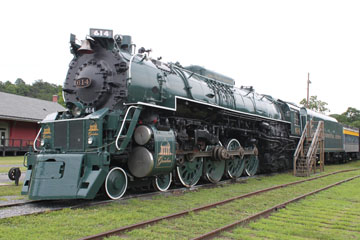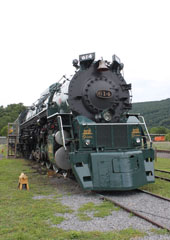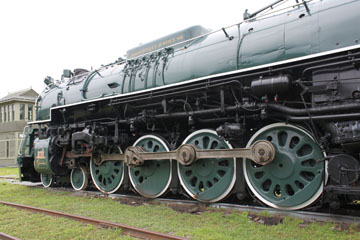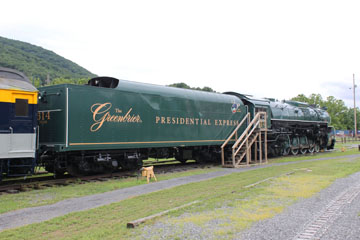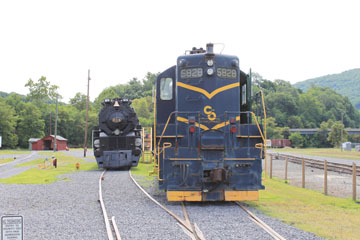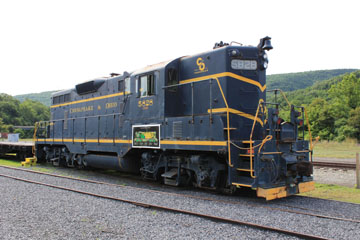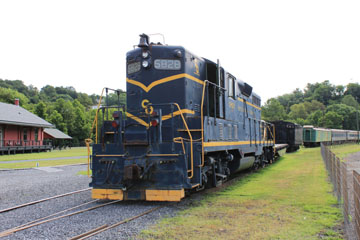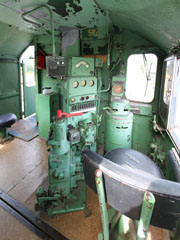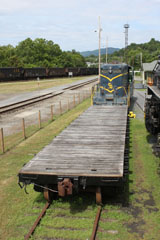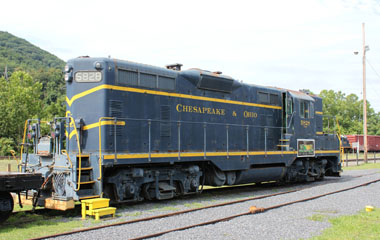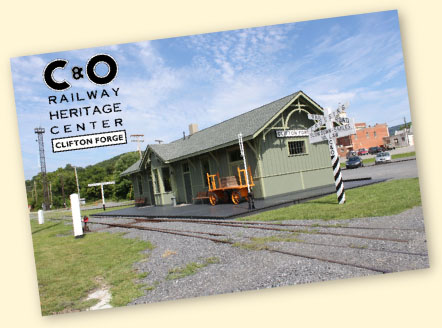

The Chesapeake & Ohio Railway Heritage Center is located in downtown Clifton Forge, VA, just off US 220 on D St. It was created by the Chesapeake and Ohio Historical Society, and is dedicated to telling the story of the C&O, its people, places and technology.
The C&O once employed over two thousand workers in Clifton Forge. Locomotives were serviced there before climbing over the Alleghany Mountains to West Virginia or east over the Blue Ridge Mountains to Newport News, VA. The museum occupies the site of what were once large shop facilities for repairing locomotives, a major classification yard, an icing facility, the main laundry for the entire railroad, a passenger coach yard and division headquarters for the region.
With the advent of diesel engines in the early 1950s, the C&O relocated its maintenance shops to West Virginia. Many of the jobs in Clifton Forge were transferred to the new facility in Huntington, and the city of Clifton Forge began a slow decline. It has since successfully recast itself as a gateway to the many tourist and recreational activities in the area.

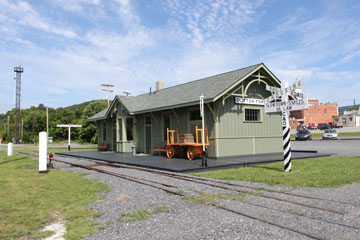
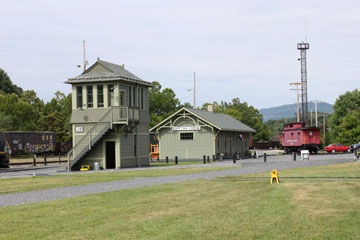
Top photo, a replica "C&O Standard Station" stands at the site of the old Clifton Forge passenger station. It houses the museum ticket office and gift shop. Bottom, a replica "C&O Standard Signal Tower" has been constructed to one side of the station building, and restored 1949 C&O Caboose #90219 is on the other side.
There are also displays in a restored freight depot just out of sight on the right of the bottom view. Built in 1895, the depot handled smaller, package freight to and from stations on the three mainlines that radiated from Clifton Forge.

When I first visited, CO J-3a #614 was parked in the yard, having just arrived from Roanoke (you can see photos of it there at the "Thoroughbreds of Steam" exhibition on the Virginia Museum of Transportation page of this website).
Although usually known as Northern type locomotives, the Chesapeake & Ohio decided to give its 4-8-4s a different name. The railroad's Greenbrier Hotel in White Sulphur Springs, WV, which was then known for its luxury and prestige, thus formed the basis for the name "Greenbrier" that was applied to them.
In all, the Chesapeake & Ohio would roster twelve 4-8-4s. They were designed to haul long, heavy, high speed express passenger trains such as the George Washington and the Fast Flying Virginian.
The first five were built by the Lima Locomotive Works in Lima, OH, in 1935 (#600-604) and designated Class J-3. Each was given the name of a Virginian statesman. Two more were ordered from Lima in 1942 (#605-606) and given the names "Thomas Nelson, Jr" and "James Monroe". In 1948, the design was changed slightly and #610-614 were produced, designated J-3a.
In 1979, the museum traded #614 with Ross Rowland for Reading #2101, which had been damaged in fire.
The following year, the restored locomotive
hauled the Chessie Safety Express, working through 1981. The locomotive was then kept in Hagerstown, MD, until 1985 when it began a short lived experiment as an alternative to rising oil costs by burning a type of coal known as ACE 3000. It then returned to Baltimore. In 1998, #614 was moved into storage on the Reading & Northern Railroad in Port Clinton, PA.
Weighing 503,500 lbs, 290,000 lbs on their eight 72" drivers, the J-3as were amongst the largest 4-8-4s built in the US.
Like most steam locomotives built after WWII, the J-3s had a comparatively short life. All twelve were retired in 1955, although a number were briefly reactivated in 1956, including #614. Shortly after, all except #614 were scrapped, and the locomotive went into storage in Russell, KY, until 1975, when it was donated to the Baltimore & Ohio Railroad Museum in Baltimore, MD, by the Chessie System, successor to the C&O.
In 1992, #614 steamed again to demonstrate Rowland's vision of his proposed 21st Century Express. One side of the locomotive was shrouded in blue streamlining and the headlight was centred.
Three years later, #614 was pulled to the New Hope & Ivyland Railroad in Pennsylvania for a complete overhaul. The overhaul was completed
in 1996 and the locomotive was moved to
Hoboken, NJ, from where it hauled a series of very successful excursions to Port Jervis, NY, and return.
Unlike the first five
J-3s, the J-3a was fitted with Boxpok drivers and Baker valve gear instead of Walschaert.
The locomotive axles were fully roller-bearing equipped, with lightweight rods and roller bearings on all cranks.
In 1998, #614 went into storage on the Reading & Northern Railroad in Port Clinton, PA. Two years later, Rowland put the locomotive up for auction, but no buyers met the reserve price.
At the time of my first visit, #614 was about to be repainted green and moved to White Sulphur Springs, WV, to go on display at the Greenbrier Resort to promote the Greenbrier Express, a proposed new luxury service between Washington, DC, and the Greenbrier. However, it was still at the museum the last time I visited, awaiting its potential return to steam.
#614 has 27½" x 30" cylinders. It operated at a boiler pressure of 255 psi and delivered 68,299 lbs tractive effort.
The locomotive is 112' 3" long (engine and tender), with an engine wheelbase of 46' 10", and a driver wheelbase 19' 3".
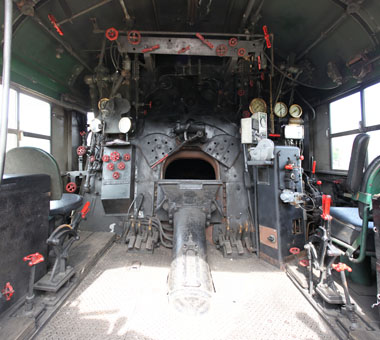
Above, #614's backhead. It has a 100.3 sq ft grate and 520 sq ft firebox.
The total heating surface is 7,800 sq ft, including 2,305 sq ft superheating.

#614 was originally mated with a 309,700 lb tender (light) with a capacity of 21,500 gallons of water and 25 tons of coal.
The current tender weighs 386,130 lbs (light) and has a capacity of 18,200 gallons of water and 50 tons of coal.
The water bottom tender has two, three axle Buckeye Steel tender trucks.
Left and below, #614's auxiliary tender or "canteen" has a
31,800 gallon
capacity. Now that so few water tanks survive, it is required on long runs.
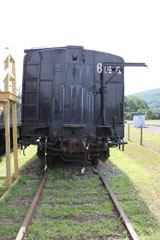
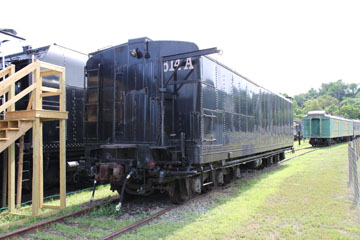
On a second visit, I caught #614 in its "Greenbrier" livery.
I'm no great fan of this scheme, although it is certainly in keeping with schemes used on name passenger trains in the heyday of steam (the Southern Pacific, Seaboard, Union Pacific, Pennsy, etc).

A number of GP7s still operate on shortlines, and many have been preserved. You can see BO #6405 on the B&O Museum Yard and Car Shop page of this website.
Several railroads modified their GP7s. ACL #1804, one of twenty GP7s built for the US Army Transportation Corps in 1951, still operates. It has a short hood, and you can see photos of it on the Gold Coast Railroad Museum page of this website. NW GP7U #2185 (originally built for the AT&SF as #2739 in 1952 but also modified with a short hood) is on the Crewe Railroad Museum page.
CO GP7 #5828 was moved to Clifton Forge in 2009 from Roanoke (you can see photos of it there on the Virginia Museum of Transportation page of this website).
A total of two thousand, seven hundred and twenty-nine GP7s were built by EMD and GMD between 1949 and 1954: two thousand, six hundred and fifteen for US railroads, one hundred and twelve for Canadian and two for Mexican railroads. It was an astoundingly successful locomotive, and is often credited with completing main line dieselisation in the US.
Above right, the Center has opened the cab of #5828, so you can go inside.
#5828 is 55' 11" long, 14' 6" high (to the top of the cab) and weighs 246,000 lbs. Under the hood, an EMD 567B 16-cylinder 1,500 hp prime mover drove a GM D12 generator to power four GM D-27B traction motors, one on each axle, delivering 40,000 lbs continuous tractive effort at 9.3 mph. It had a top speed of 65 mph. The GP7 was also offered without a control cab. These units were called GP7Bs, although only five were built in 1953, all for the AT&SF.






